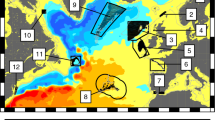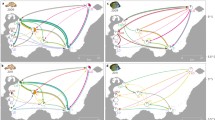Abstract
The desire to understand the observed patterns of Acanthaster population spread throughout the Great Barrier Reef (GBR) has necessitated the development of numerical models which are capable of simulating the hydrodynamics associated with large assemblages of reefs over the time scale of larval dispersal. Models are presented which provide an overview of the physical processes controlling the advection of larvae within the Cairns Section of the GBR Marine Park, on the scale of tens to hundreds of kilometres. The relevant scales and relative importance of the distinct processes are discussed. The models are based on a previously tested numerical hydrodynamic model and are validated by comparison with observations documented in the physical oceanographic literature. Overall, model outputs correspond well to our understanding of the large-scale features and dynamics of water circulation over the continental shelf. Regional variation in circulation predicted by the models may result in significant differences in the movement of larvae.
Similar content being viewed by others
References
Allen JS (1980) Models of wind-driven currents on the continental shelf. Ann Rev Fluid Mech 12:389–433
Andrews JC (1983) Water masses, nutrient levels and seasonal drift on the Outer Central Shelf (Great Barrier Reef). Aust J Mar Freshwater Res 34:821–834
Andrews JC, Bode L (1988) The tides of the Central Great Barrier Reef. Cont Shelf Res 8:1057–1085
Andrews JC, Gentien P (1982) Upwelling as a source of nutrients for the Great Barrier Reef ecosystems: a solution to Darwin's question? Mar Ecol Prog Ser 8:257–269
Black KP (1988) The relationship of reef hydrodynamics to variations in the free-borne larval numbers on and around coral reefs. Proc 6th Int Coral Reef Symp 2:125–130
Bode L, Sobey RJ (1984) Initial transients in long wave computations. J Hyd Engineering, ASCE 110:1371–1397
Bode L, Mason LB, Sobey RJ, Stark KP, (1981) Hydrodynamic studies of water movements within the Great Barrier Reef. Research Bulletin CS27, Dept Civil and Systems Engineering, James Cook University, North Queensland
Church JA (1987) The East Australian Current adjacent to the Great Barrier Reef. Aust J Mar Freshwater Res 38:671–683
Church JA, Boland FM (1983) A permanent undercurrent adjacent to the Great Barrier Reef. J Phys Oceanogr 13:1747–1749
Cresswell GR, Greig MA (1978) Currents and water properties in the North-central Great Barrier Reef during the south-east trade wind season. Aust J Mar Freshwater Res 29:345–353
Dight IJ, James MK, Bode L (1990) Modelling the larval dispersal of Acanthaster planci. II. Patterns of reef connectivity. Coral Reefs 9:125–134
Frith CA, Leis JM, Goldman B (1986) Currents in the Lizard Island region of the Great Barrier Reef lagoon and their relevance to potential movements of larvae. Coral Reefs 5:81–92
Frith CA, Mason LB (1986) Modelling wind driven circulation One Tree Reef, Southern Great Barrier Reef. Coral Reefs 4:201–211
Griffin DA, Middleton JH, Bode L (1987) The tidal and longer-period circulation of Capricornia, Southern Great Barrier Reef. Aust J Mar Freshwater Res 38:461–474
Hamon BV (1984) Diurnal and semi-diurnal tides on the Great Barrier Reef. Report 163, CSIRO Mar Lab
Kenchington RA (1977) Growth and recruitment of Acanthaster planci (L.) on the Great Barrier Reef. Biol Conserv 11:103–118
Middleton JH (1987) Steady coastal circulation due to alongshore pressure gradients. J Phys Oceanogr 17:604–612
Moran PJ (1986) The Acanthaster phenomenon. Oceanogr Mar Biol Ann Rev 24:379–480
Oliver JK, Willis BL (1987) Coral-spawn slicks in the Great Barrier Reef: preliminary observations. Mar Biol 94:521–529
Pickard GL, Donguy JR, Henin C, Rougerie F (1977) A review of the physical oceanography of the Great Barrier Reef and Western Coral Sea. Aust Inst Marine Science, Monograph Series, vol 2
Prandle D (1978) Residual flows and elevations in the southern North Sea. Proc R Soc Lond A 359:189–228
Rothlisberg PC, Church JA, Forbes AMG (1983) Modelling the advection of vertically migrating shrimp larvae. J Mar Res 41:511–538
Sammarco PW, Andrews JC (1988) Localized dispersal and recruitment in Great Barrier Reef corals: the Helix experiment. Science 239:1422–1424
Sobey RJ, Harper BA, Stark KP (1977) Numerical simulation of tropical cyclone storm surge. Research Bulletin CS14, Dept Civil and Systems Engineering, James Cook University, North Queensland
Sobey RJ, Harper BA, Mitchell GM (1980) Numerical modelling of tropical cyclone storm surge. Proc 17th Int Conf Coastal Eng, Sydney, March 23–28
Williams DMcB, Wolanski E, Andrews JC (1984) Transport mechanisms and the potential movement of planktonic larvae in the central region of the Great Barrier Reef. Coral Reefs 3:229–236
Wolanski E, Bennett AF (1983) Continental shelf waves and their influence on the circulation around the Great Barrier Reef. Aust J Mar Freshwater Res 34:23–47
Wolanski E, Pickard GL (1983a) Currents and flushing of Britomart Reef lagoon, Great Barrier Reef. Coral Reefs 2:1–8
Wolanski E, Pickard GL (1983b) Upwelling by internal tides and Kelvin waves at the continental shelf break on the Great Barrier Reef. Aust J Mar Freshwater Res 34:65–80
Wolanski E, Pickard GL (1985) Long term observations of currents on the Central Great Barrier Reef continental shelf. Coral Reefs 4:47–57
Wolanski E, Jupp DLB, Pickard GL (1986) Currents and coral reefs. Oceanus 29:83–89
Wu J (1980) Wind-stress coefficients over sea surface near neutral conditions a revisit. J Phys Oceanogr 10:727–740
Yamaguchi M (1973) Recruitment of coral reef asteroids, with emphasis on Acanthaster planci (L.). Micronesica 9:207–212
Yamaguchi M (1986) Acanthaster planci infestations of reefs and coral assemblages in Japan: a retrospective analysis of control efforts. Coral Reefs 5:23–30
Author information
Authors and Affiliations
Rights and permissions
About this article
Cite this article
Dight, I.J., Bode, L. & James, M.K. Modelling the larval dispersal of Acanthaster planci . Coral Reefs 9, 115–123 (1990). https://doi.org/10.1007/BF00258222
Accepted:
Issue Date:
DOI: https://doi.org/10.1007/BF00258222




